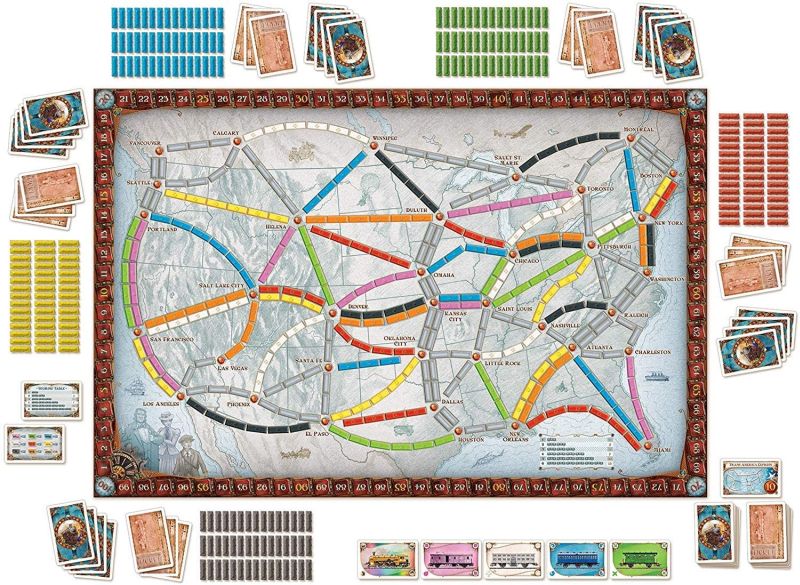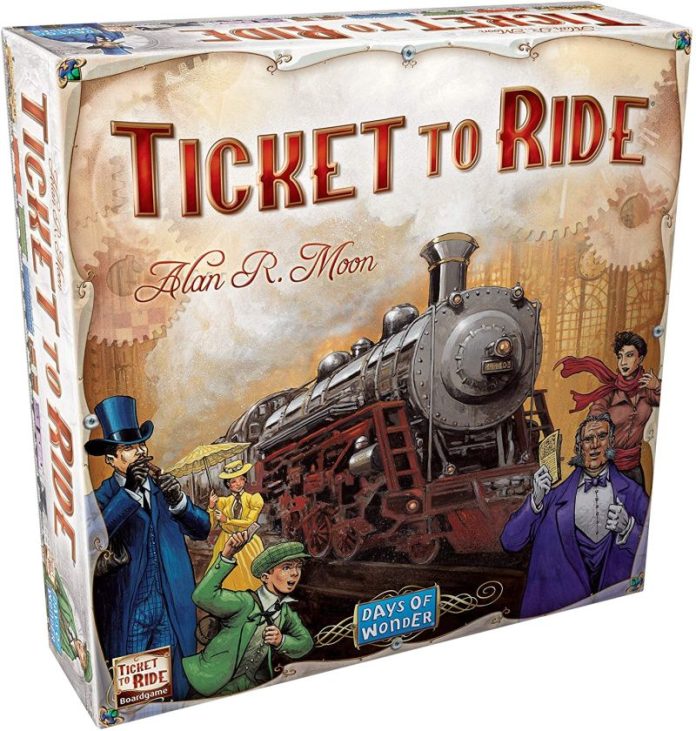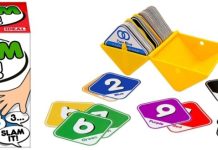I spend a lot of time going back and forth on the trains (and in the north of England, at times, that can be quite a challenge), so was playing a board game based on cross-country train journeys going to be of any interest? To be fair, it wasn’t! I had the game sitting around for quite a while before I attempted to play it, but what a brilliant game, strategic play and lots of fun. I can see why it has won dozens of international awards and sold over 8 million games to become one of the most popular modern board game series to date!
Ticket to Ride is a family-friendly cross-county train travelling strategy game, a game that requires planning, thinking ahead and strategic blocking. Players need to collect cards of various types of train cars that enable them to claim railway routes connecting cities (in this version it’s the USA). The longer the route claimed, the more points you earn. It is a game for 2-5 players, aged 8+ and has a playing time of 30-60 minutes. Don’t do what I did and judge the game by its cover and description or think it’s a game for train spotters, it is an excellent fun game whether you like trains or not.
In the box:
- Large Game Board of North American Train Route (6 Panels)
- 240 Coloured Trains (includes 15 spare trains)
- 5 Wooden Scoring Markers
- 110 Illustrated Train Car Cards
- 30 Destination Tickets
- Summary Card
- Rules Booklet
The aim of the game is to earn as many points as you can by placing trains and claiming train routes between different cities in North America and Canada. It is deceptively simple game to play where tactics and strategic planning will come into play to stop your opponents in their tracks, it is a game of patience and planning. What routes are you going to claim? Do you go for the shortest routes (less points) or the longer, more complicated routes (to gain the most points)? Should you block routes of your opponents and force them take a more complex route or just concentrate on your own path? The one to collect the most points (not necessarily the one with the most routes) is the winner.
Setting up the game is quick and simple and only takes a few minutes. You will need a rather large playing area to play Ticket to Ride. The game board is nice and large (made up of six panels). The board is a map that represents train routes across North America and Canada, linking various cities together. Once you unfold the board, place it in the centre of your playing area so that everybody can reach it. Each player (up to five can play) is given 45 train pieces, each person has a different colour (blue, black, green, red or yellow) along with a matching colour scoring marker. Markers are placed on the number 1 position on the numbered squares that are around the edge of the board. Shuffle the train cards (do this well, especially on the first time of playing) and deal 4 cards to each player, placing the remaining deck of cards next to the board. Take five cards from the top of the deck and place them individually face up on the table. Place the Longest Path Bonus Card face up next to the board. Shuffle the destination ticket cards and deal 3 to each player (don’t let other players see your cards). The game is now all set and ready for the fun to commence.

Reading through the rules makes the game sound more complex than it is, it is in reality quite a simple game to play. Once you start playing everything falls into place, you will just need the rules handy to check things on the first few plays.
To play, the starting player (in this case, the most experienced traveller – sorry kids, that probably won’t be you for a change – walking to and from school doesn’t count) draws two train cards from the deck or from the five face up cards on the table and then play continues around the table. On each turn each player can only complete ONE action – draw train cards, claim a route or draw destination tickets (players can draw 3 tickets, look at the cards and decide which to keep – at least one must be kept but you can decide to keep two or even all three should you wish).
The idea is to claim train routes by collecting train cards of matching colours to earn points, and the train routes are all various lengths, but the longest ones are worth a whole lot more than a collection of short routes. Locomotive cards are wild cards and can be used as any colour. When you have claimed enough matching cards to complete a route (shown by coloured spaces on the board), you can claim the route and place your trains on the board to link the cities or segments of the route together. If you place trains on the board, depending on how many trains placed determines how many points you score to move your marker around the edge of the board. If you complete a route that matches a destination card that you hold, the number in the corner of the destination card is the number of points that you will win (these are added to your score at the end of the game).
That all sounds simple enough, doesn’t it? An easy, straightforward game to play. That’s where strategy comes into play, yours and your fellow players. Lots of routes are broken up into segments and other players can claim segments of another player’s route to block them, forcing them to take much longer, indirect route or even abandoning a route. This makes the game much more challenging and fun and adds an element of strategic thinking, plotting and planning into the game.
The game comes to an end when any player has reached 2 or less trains in their train stock. This player is not necessarily the winner. To determine the overall winner, points need to be added up – points earned around the edge of the points and then all the points from completed destination routes. To make it more interesting, any uncompleted destination cards a player holds has those deducted from their score. The winner is one with most points, not the one that has got rid of most trains or collected more routes.
Overall, I absolutely loved playing this game – as did the kids. It can be a fairly long game to play, average game play is around 30-60 minutes, but our first go took about 90 minutes whilst we were fully getting to grips with it (and this just flew by and was enjoyable all the way). Once we all got into the swing of playing the game, we all found it very easy to understand and play (our youngest player was 10 years old).
Ticket to Ride is an excellent game to play. It is fun and interesting trying to figure out your best routes whilst trying to strategically block other players, and we were even learning new cities and where places are situated in North America and Canada (we got a geography lesson as we played).
The cards are small, but readable for all and the plastic train pieces are good quality and are easy to place on the board (and are just the right size to use, not too big or small – perfect for players of all ages).
With a full RRP of £39.99 it is quite an expensive board game, but you do get a lot for your money and the entertainment value you will get from it is more than worth it (especially as you can register your game online for more maps and other benefits and even play along with Amazon’s Alexa).
I think that Ticket to Ride (USA) is an excellent family-friendly strategy board game. It is lots of fun and the strategic blocking can make it quite competitive. Don’t be fooled about the trains like I was, it is not a game just for people with an interest in trains and travel – the trains are just a means to travel across a vast country and track progress. The game is suitable for kids, teenagers, adults and families – the playability is just excellent (it has been going for 18 years and is still going strong). There are also expansion packs and other versions of the game available – London, United Kingdom and Europe among many others, which I am looking forward to playing at some point.
Ticket to Ride is an excellent addition to any game cupboard. An excellent game for family game nights. A fun strategic game and without any train strikes!
Rating: 5/5
RRP: £39.99
For more information, visit www.daysofwonder.com. Available to buy from Amazon here.
![]()

















